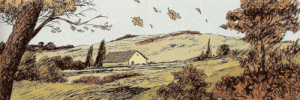Ordinary Victories by Manu Larcenet

Ordinary Victories
By Manu Larcenet (2004)
Translated by Joe Johnson. NBM, 2005. 120p., $15.95.
Life is a struggle. It may not be as “solitary, poor, nasty, brutish, and short” as Hobbes described it, but it can be long, lingering, and deteriorating; or subtly demoralizing; or chaotically random with violence and pain. Life is a struggle, and we have to enjoy our simple pleasures and our “Ordinary Victories”, the phrase that serves so aptly as a title for this brilliant graphic novel by French comic artist Manu Larcenet.
The story follows a French photographer named Marco across a few years of his life. He suffers from depression and panic attacks of unexplained origin. As the story begins he has stopped his work taking photographs in various “hot” locations in the third world (”pictures of exotic corpses or of people in the process of becoming ones”) and quits his psychoanalysis. He lives in a drafty old house out in the country, where he takes walks in the woods and clashes with a violent neighbor and meets a kindly old man.
Marco tries to find peace and sense in a chaotic world of greys. New problems, violence, and moral ambiguities, as well as his panic attacks, arrive with the passing of time. He takes photographs to try to capture an organized moment in his disorganized world, but he struggles with the place and purpose of his art in the larger community (though thankfully, this does not take up an excessive amount of the narrative).
All is not negative in Marco’s life. He meets a nice young veterinarian named Emily. He takes pleasure in his photographs, and spending time in the country, walking and swimming. He spends time with his brother playing video games and smoking “big fat joints”. Despite his many travails, Marco finds solace in his art, nature, and the company of others.
The book has no conventional plotline; rather, it tracks Marco and his experience of the world. Originally published as two albums (the traditional 50-some page French books), it has an episodic structure that fits the long term, everyday aspect of the book. The episodes are occasionally punctuated by one page interludes narrated by Marco (the rest of the book is unnarrated). The interludes consist of eight equal panels drawn in a sketchy, realistic style (that look like something out of a sketchbook) and a brownish olive palette that contrasts markedly with the book’s normal style. These pages provide some direct access to the thoughts of Marco, adding context and meaning to some of his actions. (The image here is from one of the later interludes that consist of portraits. Based on the face and the accompanying text, I am convinced this is an image of Marcel Duchamp.)
The book’s predominant style is reminiscent of that paragon of bande dessinee, Hergé. In most instances both characters and background are drawn with a similar thin line, though Larcenet’s line has a much sketchier quality than Hergé (similar in a way to Larcenet’s contemporaries Christophe Blaine and Joann Sfar)–pen strokes don’t always connect, shapes are open at the corners. The characters have a caricatural appearance, small in stature with exaggerated features (Marco’s nose is almost as big as his feet), four fingers, and dots for eyes.
The backgrounds take on different styles whether they are interiors or exteriors (See the two examples here). Larcenet’s interiors are simple and precise, lacking much detail beyond basic shape delineation. His exteriors, on the other hand, are sketchy and scribbly, with the appearance of coming straight from a life-drawing sketch. The outdoor drawings have a much more realistic appearance than the characters and the interiors, though upon closer examination they are made of many scribbles. The outside world is chaotic at heart but often coherent and structured from a distance.
Colors are flat and representational in most cases. The occasional panel breaks from this color scheme to charge an image with emotional effect. When Marco has his panic attacks or some other emotionally violent episode (learning of his father’s Alzheimer’s) the world becomes red. Flat colors used as background in panels are also often used for expressive effect.
Larcenet sticks to the traditional European four tier layout, varying the width of the panels as necessary for space or timing. He only breaks from the four tiers on four occasions, all using half page panels to stress isolation (Marco’s house, the old man’s house, Marco having a panic attack, Marco trying to drown his pain in a club amongst large, distorted dancing bodies).
While the comic does not at first glance stand out as particularly unusual or novel in its visual aspects, on repeated readings, it becomes clear how skillfully Larcenet uses the material of comics to tell his story in a subtle, almost transparent way. In one scene, when Marco visits his parents, his mother talks so much that her word balloon progressively, from panel to panel, actually covers up Marco. In another scene, Marco’s brother tells a story and the word balloon connects across two panels with tails to the two images of the brother at opposite ends of the larger balloon.
Ordinary Victories impressed and moved me from the first reading for its bluntly honest portrayal of the struggle of life tempered by the pleasures and joys of companionship, art, and nature. While an often sad and depressing story, I think it gains hope on rereading. Larcenet has created an excellent example of a graphic novel that not only represents the world in an honest way but also pays on repeated readings.
Edit: See also my post on volume three of the French as well as my review of the second volume of English translation.

